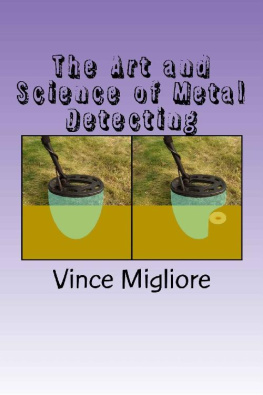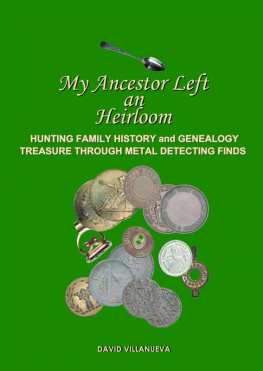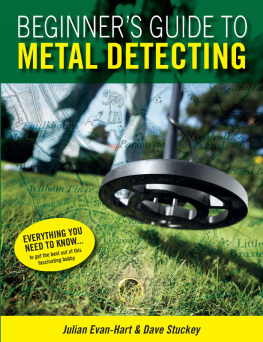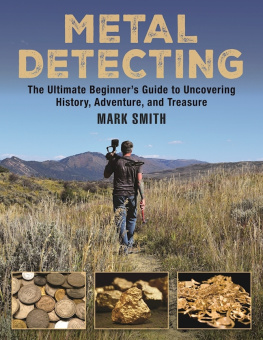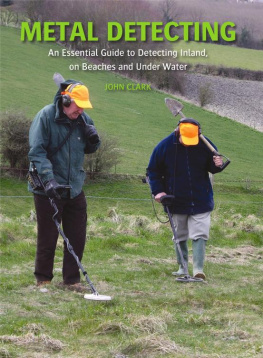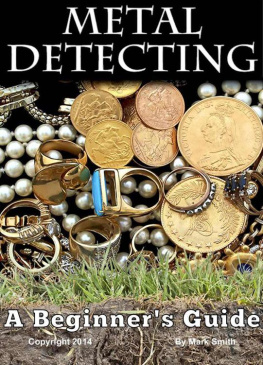Vince Migliore - The Art and Science of Metal Detecting
Here you can read online Vince Migliore - The Art and Science of Metal Detecting full text of the book (entire story) in english for free. Download pdf and epub, get meaning, cover and reviews about this ebook. year: 2015, genre: Home and family. Description of the work, (preface) as well as reviews are available. Best literature library LitArk.com created for fans of good reading and offers a wide selection of genres:
Romance novel
Science fiction
Adventure
Detective
Science
History
Home and family
Prose
Art
Politics
Computer
Non-fiction
Religion
Business
Children
Humor
Choose a favorite category and find really read worthwhile books. Enjoy immersion in the world of imagination, feel the emotions of the characters or learn something new for yourself, make an fascinating discovery.
- Book:The Art and Science of Metal Detecting
- Author:
- Genre:
- Year:2015
- Rating:3 / 5
- Favourites:Add to favourites
- Your mark:
- 60
- 1
- 2
- 3
- 4
- 5
The Art and Science of Metal Detecting: summary, description and annotation
We offer to read an annotation, description, summary or preface (depends on what the author of the book "The Art and Science of Metal Detecting" wrote himself). If you haven't found the necessary information about the book — write in the comments, we will try to find it.
The Art and Science of Metal Detecting — read online for free the complete book (whole text) full work
Below is the text of the book, divided by pages. System saving the place of the last page read, allows you to conveniently read the book "The Art and Science of Metal Detecting" online for free, without having to search again every time where you left off. Put a bookmark, and you can go to the page where you finished reading at any time.
Font size:
Interval:
Bookmark:
The Art
and Science of
Metal Detecting
Vince Migliore
BHB
Blossom Hill Books
Title ID 5726666: Kindle Edition
Title: The Art and Science of Metal Detecting
Description: The Art and Science of Metal Detecting is a user guide to choosing, understanding, and operating a metal detector.
ISBN-13:
978-1517255107
ISBN-10:
1517255104
Primary Category: Sports & Recreation / General
Country of Publication: United States
Language: English
Search Keywords: metal detecting, treasure hunting
Author: Vince Migliore
Blossom Hill Books
113 Sombrero Way
Folsom, California 95630 USA
Reorder: https://www.createspace.com/5726666
Copyright 2015 by Vince Migliore.
All rights reserved. No portion of this book may be reproduced without the express permission of the author. Brief quotations may be used for review purposes.
Cover photo: The diagram illustrates the electrical function of the detector when it finds a coin. When there is no target in the detectors field then the pick-up coil receives only a weak signal in phase with the transmit coil. When the field crosses over a coin or any metal object the detector field generates an eddy current in the target. This in turn produces a small field which opposes the detector coil field, causing a phase shift in the waveform. The amount of phase shift helps identify the target.
Phase shift is explained with other illustrations in Appendix B.
Welcome to the fabulous world of metal detecting!
This is an adventure-filled hobby where you can find coins, jewelry, historic relics and precious metals. You can help people find their lost rings and even help police in forensic discovery. The hobby goes by various names treasure hunting, dirt fishing, metal detecting, or coin-shooting. Youll have loads of fun and you can easily find enough valuables to pay for your detector.
The thrill of finding treasure is addictive. Every time that beep goes off in your headphones its like getting a free pull on a slot machine handle. Will it be a jackpot or junk? Modern metal detectors have discriminators a word you will soon become familiar with which tells if that beep is for a real coin, or just a bottle cap.
Although the search for easy treasure might be the motivating factor when you start the hobby, you will soon recognize and appreciate the many rewards of this sport. You will learn how metal detectors work, which delves into physics, electricity, and electronics. You will learn about history, geology, and geography. Hiking over hill and dale, you will learn a lot about nature, and get plenty of exercise in the process. You will see birds and animals, trees and rivers, rocks and clouds. When you dig, you will discover mud and bugs, gems and jewelry, coins and relics.
Looking for places to search, and seeking help from other people, you will become involved in all aspects of social behavior. You will learn about the history of your town, talk with property owners, and become familiar with grounds-keepers. Best of all, you will find that people are kind, helpful, and generous. This is particularly true of metal detecting club members, who will help you to learn about the sport, and guide you on your way. Best of all, you will very quickly learn to discover hidden coins and treasure, just waiting at your feet. You will carry them home, sort them out, and enjoy the wealth gained from your efforts. Metal detecting is an awesome combination of learning, adventure, exercise, and gathering treasure. So, welcome to the sport!
This is not your daddys metal detector! The old machines would beep at finding anything made of metal. Todays detectors have electronic circuitry that guarantees you will find valuables .
The technology is called discrimination something we will discuss later on that identifies the object in the ground even before you start digging! This makes it possible to dig only the worthwhile finds and speeds up the treasure collection process.
Discrimination (the positive meaning of that word) allows Target Identification the ability to tell the difference between a quarter and a bottle cap, between a penny and a dime, or between any coin and a piece of junk. The detector can tell you if its a penny, a quarter, a dollar coin or precious metal. In this way, you can eliminate the long process of digging only to find its a metal washer and not a coin. See Figure 1.
Modern detectors often have built-in pin-pointers to help you zero in on the exact location. Many will tell you how many inches deep it is too. All you do is swing the detector, read the display, and you make the choice to dig it up or not.
In a nutshell, the modern metal detector is a money-making machine. The ability to discriminate between buried coins and plain old trash enables you to retrieve valuables at a much faster rate than the old-timers did.

Figure 1. A modern metal detector can identify which coin it is sensing. Here a Whites detector shows an ID number 18, indicating a 5-cent coin or a ring.
A quick overview:
- Above all else, you must understand the concepts of Discrimination and Target ID in order to evaluate which detector is best for you. These technical terms are defined in Chapter 3 , The Science of the Metal Detector .
- Next, its advisable to know which types of metal detecting are available in your area. If you live in Oregon, for example, you may not be looking for Civil War relics. This topic is also covered in Chapter 3.
- Finally, consider your budget and activity level. You dont want to spend a small fortune on a detector just to see it collect dust in your garage. Costs and trade-offs are discussed in Chapter 4, The Art of Choosing a Detector .
In this book you will learn how to:
- Choose the best detector for your needs
- Find the types of detecting (coins, jewelry, relics, gold prospecting) best suited for your area
- Find clubs, friends, and metal detecting resources
- Locate the hot search sites for your town
- Research local history that will point towards long-forgotten search areas
- Discover old maps and references to help locate good places to hunt
- Examine your target area from birds-eye and street level views to choose the best approach for metal detecting.
Most of the research can be completed with a few mouse clicks on the internet. As an example, you might be looking for old campgrounds. The internet has plenty of auction sites where you can buy reference guides to campsites in your area from the 1960s. You can buy one for about $5.00 on Ebay.com. Compare it to a modern map and you will see which campgrounds are still around and which have been abandoned or built over. Then use sites such as Google Earth or Panormaio.com to look at photos of these areas. They might be in a state park that charges a parking fee, but the aerial map shows an entrance from a residential area that is free. Study the online maps and even before you get there you know exactly what the terrain looks like and where youll go to search.
The main piece of equipment you will need is a metal detector. This is composed of an electronic control box that processes the signal and gives you signal that youve located a metal object. The output can be a sound, a reading on a volt-meter, a display of a number on an LCD screen, or any combination of such methods. The detector will also have a grip and arm-rest, and a shaft to hold the search coil. The sound output goes to a speaker which is usually bypassed by plugging in a set of headphones. See Figure 2.
Font size:
Interval:
Bookmark:
Similar books «The Art and Science of Metal Detecting»
Look at similar books to The Art and Science of Metal Detecting. We have selected literature similar in name and meaning in the hope of providing readers with more options to find new, interesting, not yet read works.
Discussion, reviews of the book The Art and Science of Metal Detecting and just readers' own opinions. Leave your comments, write what you think about the work, its meaning or the main characters. Specify what exactly you liked and what you didn't like, and why you think so.

